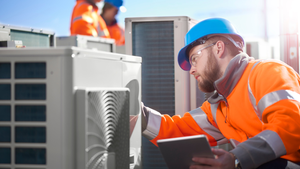
Omnia Partners
For government fleet managers, the shift to EVs takes planning, training and fundingFor government fleet managers, the shift to EVs takes planning, training and funding
Because of the urgent need for decarbonization and reducing climate change, local government fleet managers are facing several major trends. One of these is the shift from internal combustion engines to electric vehicles (EVs), says Sam Pournazeri, senior director of Clean Transportation & Energy at ICF, a global consulting and technology services company with approximately 9,000 employees that helps organizations, including public- and private-sector clients, solve their complex challenges.
September 6, 2024

Because of the urgent need for decarbonization and reducing climate change, local government fleet managers are facing several major trends. One of these is the shift from internal combustion engines to electric vehicles (EVs), says Sam Pournazeri, senior director of Clean Transportation & Energy at ICF, a global consulting and technology services company with approximately 9,000 employees that helps organizations, including public- and private-sector clients, solve their complex challenges. The firm aids organizations in transportation electrification, including the shift to EVs.
“Many local governments across the country have set ambitious climate targets, recognizing the substantial contribution of their vehicle fleets to their overall carbon footprint. Transitioning these fleets away from internal combustion engines (ICEs) to EVs has become a key strategy in their efforts to reduce emissions,” Pournazeri explains.
He says the transition to EVs offer a promising avenue for reducing operational and maintenance costs. “Compared to traditional internal-combustion-engine vehicles, EVs have fewer moving parts, which translates to lower maintenance needs and costs. Additionally, electricity as a fuel source is generally cheaper than gasoline or diesel, leading to further operational savings.”
But as these fleet managers begin to pivot towards electric vehicles, they face a dual challenge. “On one hand, procurement of EVs, while familiar territory, introduces new considerations such as vehicle range and availability. On the other hand, a more daunting task lies in the build-out of charging infrastructure. This aspect of the transition is particularly challenging because it falls outside the traditional scope of fleet management,” Pournazeri tells Co-op Solutions. He notes that many fleet managers possess limited knowledge about the specifics of charging technology, installation requirements, and the logistical planning needed to ensure that infrastructure keeps pace with fleet electrification.
Pournazeri says there’s another significant hurdle: the maintenance of these new-technology vehicles. “Traditional fleet maintenance shops and technicians are predominantly trained and equipped to handle ICE vehicles. The shift to EVs requires a different set of skills and knowledge, particularly in electrical systems and battery management. The lack of workforce development programs and a shortage of technicians trained to service EVs represent a critical challenge.” The ICF official adds: “This workforce gap not only affects the maintenance and operational readiness of the fleet, but also poses a barrier to the broader adoption of EVs within local government operations.”
To improve fleet performance, Pournazeri urges fleet managers to conduct regular, thorough analyses of their fleet operations. “This proactive approach involves evaluating operational efficiency, vehicle utilization, and maintenance practices to identify any inefficiencies or areas for improvement. By assessing their fleet’s performance and needs regularly, local governments can make informed decisions about transitioning to more efficient technologies, rightsizing or downsizing their fleet, and implementing other strategic changes.”
He says such an analysis not only helps pinpoint where resources may be underutilized or overspent, but also paves the way for adopting innovations that can lead to significant cost savings, enhanced operational efficiency, and reduced environmental impact. “Emphasizing continuous evaluation and adaptation ensures that fleet operations remain optimal and aligned with their evolving needs.” Pournazeri outlines a few key steps for fleet managers:
Conduct comprehensive fleet transition planning, including rightsizing. “Before embarking on significant changes, such as adopting new technologies or transitioning to EVs, it’s crucial to conduct a comprehensive fleet transition planning exercise. This planning should include a rightsizing analysis to ensure the fleet is optimally sized for its operational needs.” The ICF executive says rightsizing involves evaluating the current fleet to determine if each vehicle is necessary, appropriately utilized and the right type for its intended purpose.
Implement fleet management and telematics systems. Leveraging technology such as fleet management software and telematics can significantly improve operational efficiency. These systems provide real-time data on vehicle location, fuel consumption, maintenance needs and driver behavior.
Pournazeri says this information can be invaluable for optimizing routes, scheduling preventive maintenance, reducing fuel consumption and improving overall fleet safety. “Having access to detailed analytics, fleet managers can make informed decisions that lead to cost savings and enhanced operational efficiency.”
Adopt a preventive maintenance strategy. Implementing a preventive maintenance strategy, supported by data from telematics and fleet management systems, can prevent minor issues from becoming major problems. “This approach not only extends the lifespan of the fleet but also ensures vehicles are operating efficiently and safely, reducing unexpected downtime and associated costs.”
Explore funding opportunities. Transitioning to more efficient fleet operations, especially with the adoption of EVs and the necessary charging infrastructure, requires significant investment. “To alleviate some of the financial burdens, fleet managers should actively explore federal and state grants, incentives, and partnerships. Many governments offer financial support for initiatives that reduce emissions and promote energy efficiency.”
Pournazeri says these funds can be instrumental in covering the costs associated with the purchase of EVs, the build-out of charging infrastructure, and workforce development programs.
Focus on workforce development. As fleets evolve, particularly with the introduction of EVs and advanced technological systems, the need for a skilled workforce becomes more critical. “Investing in training and equipment upgrades is essential for preparing your maintenance facilities to handle new technologies. Developing partnerships with educational institutions and industry organizations can help create tailored training programs that equip technicians with the skills needed to maintain and repair modern vehicles, including EVs.”
Pournazeri adds that this approach ensures that your workforce stays ahead of technological advancements and can efficiently manage the transition to and maintenance of EVs.
Engage in continuous improvement. Fleet management is an evolving field, with new technologies and practices popping out on a regular basis. “Staying informed about industry trends, attending workshops and conferences, and engaging with peer networks can provide valuable insights and ideas for further improving fleet operations.”
Pournazeri says fleet managers should investigate programs and training courses that help local governments train, recruit and hire more fleet mechanics as mechanics retire. “These programs often focus on bridging the skills gap and ensuring that new hires are prepared to work with both traditional internal-combustion-engine vehicles and emerging technologies such as EVs.” Potential resources include:
National Institute for Automotive Service Excellence (ASE) certification programs.
National Association of Fleet Administrators (NAFA) fleet management certification.
Electric vehicle training programs. One example is the Electric Vehicle Infrastructure Training Program (EVITP). In addition, community colleges and vocational schools may offer specialized programs or courses on EV maintenance and repair.
Manufacturer-specific training. Pournazeri notes that many vehicle manufacturers offer training programs on the maintenance and repair of their vehicles. “This can be especially useful for fleets that utilize a significant number of vehicles from specific manufacturers, including EVs and hybrids.”
Michael Keating is senior editor for American City & County. Contact him at [email protected].
.jpg?width=100&auto=webp&quality=80&disable=upscale)
.jpg?width=400&auto=webp&quality=80&disable=upscale)







